When Columbus landed on the island of San Salvador, known as Guanahani by the natives, in 1492 he was welcomed by a brown-skinned people whose physical appearance confirmed him in his opinion that he had at last reached India, and whom, therefore, he called Indios. Indians, a name which however mistaken in its first application, continued to hold its own, and has long since won general acceptance, except in strictly scientific writing, where the more exact term American is commonly used. As exploration was extended north and south, it was found that the same race was spread over the whole continent, from the Arctic shores to Cape Horn, everywhere alike in the main physical characteristics, with the exception of the Eskimo in the extreme North, whose features suggest the Mongolian.
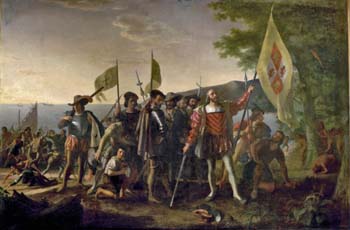
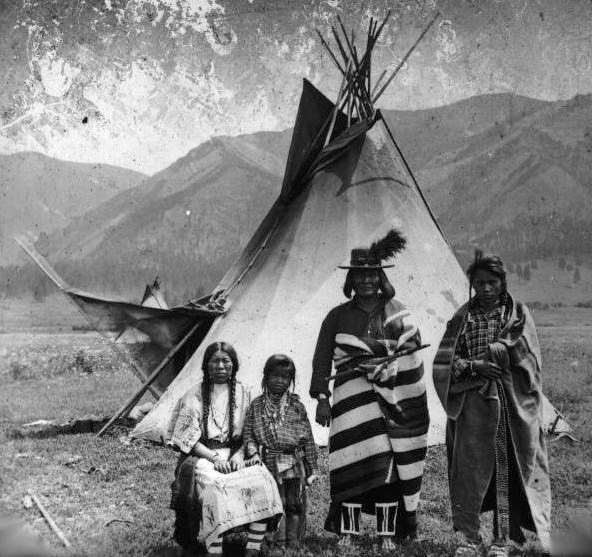
Race Type: The most marked physical characteristics of the Indian race type are brown skin, dark brown eyes, prominent cheek bones, straight black hair, and scantiness of beard. The color is not red, as is popularly supposed, but varies from very light in some tribes, as the Cheyenne, to almost black in others, as the Caddo and Tarimari. In a few tribes, as the Flatheads (family pictured on right), the skin has a distinct yellowish cast. The hair is brown in childhood, but always black in the adult until it turns grey with age. Baldness is almost unknown. The eye is not held so open as in the Caucasian and seems better adapted to distance than to close work. The nose is usually straight and well shaped, and in some tribes strongly aquiline. Their hands and feet are comparatively small. Height and weight vary as among Europeans, the Pueblos averaging but little more than five feet, while the Cheyenne and Arapaho are exceptionally tall, and the Tehuelche of Patagonia almost massive in build. As a rule, the desert Indians, as the Apache, are spare and muscular in build, while those of the timbered regions are heavier, although not proportionately stronger. The beard is always scanty, but increases with the admixture of white blood. The mistaken idea that the Indian has naturally no beard is due to the fact that in most tribes it is plucked out as fast as it grows, the eyebrows being treated in the same way. There is no tribe of "white Indians", but albinos with blond skin, weak pink eyes and almost white hair are occasionally found, especially among the Pueblos.
Origin and Antiquity: Various origins have been assigned to the Indian race from Europe and the East, by way of Greenland or the mythic land of Atlantis, and from Asia by way of the Bering Straits and the Polynesian Islands, which has more advocates, and also more reasons in its favor. The fact that Japanese and other Asiatic adventurers have frequently landed upon the North Pacific coast of America is a matter of history, and tribal tradition and other evidence indicate that such contact was as frequent in prehistoric times, but whether all this has been sufficient to make permanent impression upon the physique and culture, let alone to account for a race, is an open question.
The numerous mounds and other earthworks scattered over the eastern United States, with the cliff-ruins and other house ruins in the South-West, have also given opportunity for much speculation and theorizing as to the former existence in these regions of former highly civilized nations now extinct. Scientific examination, however, shows that the Native Americans Historyruins and earthworks are of the most rudimentary architectural chara/images/cter, being rude in construction, and inexact and unsymmetrical in dimensional measurements, while the various artifacts found within them are almost identical with those still in use by the uncivilized tribes.
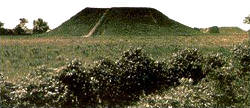
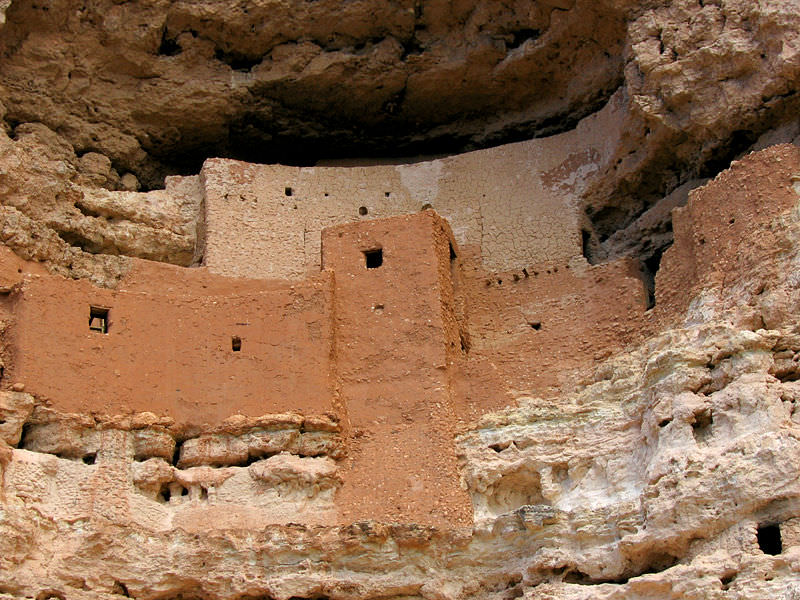
The more important house ruins are historically or traditionally known to have been built and occupied by ancestors of the Pueblo, Pima, and other tribes still inhabiting the same region. Some of the mounds of the eastern section are also known to have been in use as foundations of tribal "townhouses" within the historic period, but the majority of the larger earthworks, as those of Cahokia in Illinois, of Etowah in Georgia, the Serpent Mound and and Newark earthworks in Ohio, are more ancient, and probably originated with more populous tribes with afterwards moved down into more southern regions. The Aztec themselves, according to definite tribal tradition, reached the valley of Mexico from the far North, and linguistic evidence established their connection with the great Shoshonian linguistic stock whose tribes extend almost continuously along the backbone of the continent from the Columbia River to the Isthmus of Panama. 4" align="right" hspace="10" vspace="10">
In the same way the Apache and Navajo of the Mexico border are known to have emigrated from the frozen shores of the Yukon and Mackenzie. As in Europe and Asia, the general movement was from north to south, but the Algonkian (Ojibwa, etc.) and Siouan (Sioux, etc.) tribes moved westward from the Atlantic seaboard, while the Muskhogean of the Gulf states had their earlier home west of the Mississippi. One great South American stock, the Arawakan, after occupying the Antilles, completed the chain of connection by planting a colony in Florida.
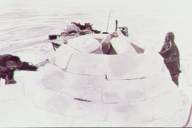
Languages: One of the remarkable facts in American ethnology is the great diversity of languages. The number of languages and well-marked dialects may well have reached one thousand, constituting some 150 separate linguistic stocks, each stock as distinct from all the others as the Aryan languages are distinct from the Turanian or the Bantu. Of these stocks, approximately seventy were in the northern, and eighty in the southern continent. They were all in nearly the same primitive stage of development, characterized by minute exactness of description with almost entire absence of broad classification. Thus the Cherokee, living in a country abounding in wild fruits, had no word for grape, but had instead a distinct descriptive term for each of the three varieties with which he was acquainted. In the same way, he could not simply say "I am here", but must qualify the condition as standing, sitting, etc. To facilitate intertribal communication, we frequently find the languages of the more important tribes utilized by smaller tribes throughout the same region, as Comanche in the southern plains and Navajo (Apache) in the South-West. From the same necessity have developed certain notable trade jargons, based upon some dominant language, with incorporations from many others, including European, all smoothed down and assimilated to a common standard. Chief among these were the "Mobilian" of the Gulf states based upon Choctaw; the "Chinook jargon" of the Columbia and adjacent territories of the Pacific coast, a remarkable conglomerate based upon the extinct Chinook language; and the lingoa geral of Brazil and the Paran region, based upon Tu/Guaran. To these must be added the noted "sign language" of the plains, a gesture code, which answered every purpose of ordinary intertribal intercourse from Canada to the Rio Grande.

Houses: In and north of the United States there were some twenty well-defined types of native dwellings, varying from the mere brush shelter to the five-storied pueblo. In the eastern United States and adjacent parts of Canada the prevailing type was that commonly known under the Algonkian name of wigwam, of wagon-top shape, with perpendicular sides and ends and rounded roof, and constructed of stout poles set in the ground and covered with bark or with mats woven of grass or rushes. Doorways at each end served also as windows, and openings in the roof allowed the smoke to escape. Not even pueblo architecture had evolved a chimney. In general the houses were communal, several closely related families occupying the same dwelling. The Iroquois houses were sometimes one hundred feet in length, divided into compartments about ten feet square, opening upon a central passageway along which were ranged the fires, two families occupying opposite compartments at the same fire. Raised platforms around the sides of the room were covered with skins and served both as seats and beds.

The houses of a settlement were usually scattered irregularly, according to the convenience of the owner, but in some cases, especially on disputed tribal frontiers, they were set compactly together in regular streets, and surrounded by strong stockades. The Iroquois stockaded forts had platforms running around on the inside, near the top, from which the defenders could more easily shoot down upon the enemy. In the Gulf states, every important settlement had its "town-house", a great circular structure, with conical roof, built of logs, and devoted to councils and tribal ceremonials. The tipi (the Sioux name for house) or conical ten/dwelling of the Native Americans Historyupper lake and plains region was of poles set lightly in the ground, bound together near the top, and covered with bark or mats in the lake country, and with dressed buffalo skins on the plains. It was easily portable, and two women could set it up or take in down within an hour. On ceremonial occasions the tipi camp was arranged in a great circle, with the ceremonial "medicine lodge" in the center. The semi-sedentary Pawnee Mandan, and other tribes along the Missouri built solid circular structures of logs, covered with earth, capable sometimes of housing a dozen families. The Wichita and other tribes of the Texas border built large circular houses of grass thatch laid over a framework of poles. The Navaho hogan, was a smaller counterpart of the Pawnee "earth lodge". The communal pueblo structure of the Rio Grande region consisted of a number sometimes hundreds of square-built rooms of various sizes, of stone or adobe laid in clay mortar, with flat roof, cour/yards, and intricate passage ways, suggestive of oriental things. The Piute wikiup of Nevada was only one degree above the brush shelter of the Apache. California, with its long stretch from north to south, and its extremes from warm plain to snow clad sierra, had a variety of types, including the semi-subterranean. Along the whole north-west coast, from the Columbia to the Eskimo border, the prevailing type was the rectangular board structure, painted with symbolic designs, and with the great totem pole carved with the heraldic crests of the owner, towering above the doorway. On the Yukon we find the subterranean dwelling, while the Eskimo had both the subterranean house and the dome-shaped iglu, built of blocks of hardened snow. Besides the regular dwellings, almost every tribe had some style of temporary structure, besides "sweat houses", summer arbors, provision caches, etc.
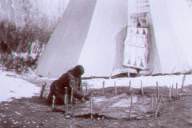

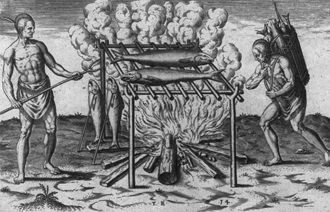
Food and its Procurement: In the timbered regions of the eastern and southern states and the adjacent portions of Canada, along the Missouri and among the Pueblos, Pima, and other tribes of the southwest, the chief dependence was upon agriculture, the principal crops being corn, beans, and squashes, besides a native tobacco. The New England tribes understood the principal of manuring, while those of the arid south-west built canals and practiced irrigation. Along the whole ocean-coast, in the lake regions and on the Columbia, fishing was an important source of subsistence. On the south Atlantic seaboard elaborate weirs were in use, but elsewhere the hook and line, the seine or the harpoon, were more common. Clams and oysters were consumed in such quantities along the Atlantic coast that in some favorable gatherin/places empty shells were piled into mounds ten feet high. From central California northward along the whole west coast, the salmon was the principle, and on the Columbia, almost the entire, food dependence. The northwes/coast tribes, as well as the Eskimo, were fearless whalers. Everywhere the Native Americans Historywild game, of course, was an important factor in the food supply, particularly the deer in the timber region and the buffalo on the plains. The nomad tribes of the plains, in fact, lived by the buffalo, which, in one way or another, furnished them with food, clothing, shelter, household equipment, and fuel. In this connection there were many curious tribal and personal taboos founded upon clan traditions, dreams, or other religious reasons. Thus the Navajo and the Apache, so far from eating the meat of a bear, refuse even to touch the skin of one, believing the bear to be of human kinship. Besides the cultivated staples, nuts, roots and wild fruits were in use wherever procurable. The Indians of Native Americans Historythe Sierras lived largely upon acorns and pinons.
Those of Oregon and the Columbia region gathered large stores of camas and other roots, in addition to other species of berries. The Apache and other southwestern tribes gathered the cactus fruit and toasted the root of the maguey. The tribes of the upper lake region made great use of wild rice, while those of the Ohio Valley made sugar from the sap of the maple, and those of the southern states extracted a nourishing oil from the hickory nut. Pemmican and hominy are Indian names as well as Indian inventions, and maple sugar is also an aboriginal discovery. Salt was used by many tribes, especially on the plains and in the southwest, but in the Gulf states lye was used instead.
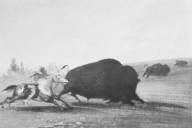

Domesticated Animals: The dog was practically the only domesticated animal before the advent of the whites and was found in nearly all tribes, being used as a beast of burden by day and as a constant sentinel by night. He was seldom, if ever, trained to hunting. Eagles and other birds were occasionally kept for their feathers. The horse, believed to have been introduced by the Spaniards, speedily became as important a factor in the life of the plains tribes as the buffalo itself. In the same way sheep and goats, introduced by the early Franciscans, have become the chief source of wealth to the Navajo, numbering now half a million animals from which they derive an annual income of over a million dollars.
Industries and Arts: In the fabrication of domestic instruments, weapons, ornaments, ceremonial objects, boats, seines, and traps, in house-building and in the making of pottery and baskets, considerable ingenuity was shown in both design and the infinite patience of execution. In the division of labor, the making of weapons, hunting and fishing requirements, boats, pipes, and most ceremonial objects fell to the men, while the domestic arts of pottery and baske/making, weaving and dressing of skins, the fashioning of clothing and the preparation and preservation of food commonly devolved upon the women. Among the sedentary or semi-sedentary tribes house-building belonged usually to the men, although the women sometimes assisted. On the plains the entire making and keeping of the tipi wasNative Americans History appointed to the women. In many tribes the man cut, sewed, and decorated his own buckskin suit, and in some of the Pueblo villages the men were the baske/weavers. While the house, in certain tribes, evinced considerable architecture skill, its prime purpose was always utilitarian, and there was usually but little attempt at decorative effect, excepting the Haida, Tlingit, and others of the north-west coast, where the great carved and painted totem poles, sometimes sixty feet in height, set up in front of every dwelling, were a striking feature of the village picture. The same tribes were notable for their great sea-going canoes, hollowed out from a single cedar trunk, elaborately carved and painted, and sometimes large enough to accommodate forty men. The skin boat, or kayak, of the Eskimo was a marvel of lightness and buoyancy, being practically unsinkable. The birch-bark canoe of the eastern tribes was especially well-adapted to its purposes of inland navigation. In the southern states we find the smaller "du/out" log canoe. On the plains the boat was virtually unknown, except for the tub-shaped skin boat of the Mandan and associated tribes of the upper Missouri.
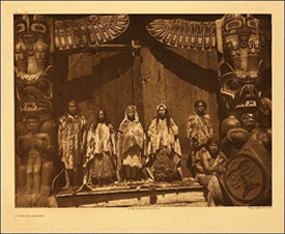
The Eskimo were noted for their artistic carvings of bones and walrus ivory; the Pueblo for their turquoise-inlaid work and their wood carving, especially mythological figurines, and the Atlantic and California coast tribes for their work in shell. The wampum, or shell beads, made chiefly from the shells of various clams found along the Atlantic coast have become historic, having been extensively used not only for dress ornamentation, but also on treaty belts, as tribal tribute, and as a standard of value answering the purpose of money. The ordinary stone hammer or club, found in nearly every tribe, represented much patient labor, while the whole skill of the artist was frequently expended upon the stone-carved pipe. The black stone pipes of the Cherokee were famous in the southern states, and the red stone pipe of catlinite from a single quarry in Minnesota was reputed sacred and was smoked at the ratification of all solemn tribal engagements throughout the plains and the lake-region. Knives, lance-blades, and arrow-heads were also usually of stone, preferably flint or obsidian. Along the Gulf Coast, keen-edged knives fashioned from split canes were in use. Corn mortars and bowls were usually of wood in the timber region and of stone in the arid country. Hide-scrapers were of bone, and spoons of wood or horn. Metal-work was limited chiefly to the fashioning of gorgets and other ornaments hammered out from native copper, found in the southern Alleghenies, about Lake Superior, and about Copper River in Alaska. The art of smelting was apparently unknown. Under Franciscan and later Mexican teaching, the Navahos have developed a silver-working art which compares in importance with their celebrated baske/weaving, the material used being silver coins melted down in stone molds of their own carving. Mica was mined in the Carolina mountains by the local tribes and fashioned into gorgets and mirrors, which found their way by trade as far as the western prairies.
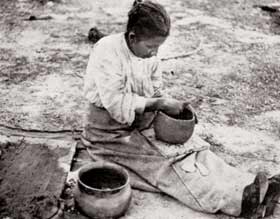
All of these arts belonged to the men. The making of pottery belonged to the women and was practiced in nearly all tribes, excepting those in the plains and interior basin and the cold north. The Eastern pottery is usually decorated with stamped patterns. That of the Pueblo and other south-western tribes was smooth and painted over with symbolic designs. A few specimens of glazed ware have been found in the same region, but it is doubtful if the process is of native origin. The Catawba (pictured left) and some other tribes produced a beautiful black ware by burning the vessel under cover, so that the smoke permeated the pores of the clay. The simple hand process by coiling was universally used. Baske/weaving in wood splits, cane, rushes, yucca or bark fiber and various grasses was practiced by the same tribes which made pottery, and excepting in a few tribes, was likewise a woman''s work. The basket was stained in Native Americans Historyvarious designs with vegetable dyes. The Cherokee made a double-walled basket.
Those of the Choctaw, Pueblo tribes, Jicarillo, and Piute were noted for beauty of design and execution, but the Pomo and other tribes of California excelled in all closeness and delicacy of weaving and richness of decoration, many of their grass baskets being water-tight and almost hidden under an inter-weaving of brigh/colored plumage, and further decorated around the top with pendants of shining mother-of-pearl. The weaving of grass or rush mats for covering beds or wigwams may be considered as a variant of the baske/weaving process, as likewise the delicate porcupine quill applique work of the northern plains and upper-Mississippi tribes. The useful art of skin-dressing also belonged exclusively to the women, excepting along the Arctic coasts, where furs, instead of denuded skins, were worn by the Eskimo, while the entrails of the larger sea animals were also utilized for waterproof garments. The skins in most general use were those of the buffalo, elk and deer, which were prepared by scraping, stretching, and anointing with various softening or preservative mixtures, of which the liver or brains of the animal were commonly a part. The timber tribes generally smoked the skins, a process unknown on the plains. A limited use was made of bird skins with the feathers intact.

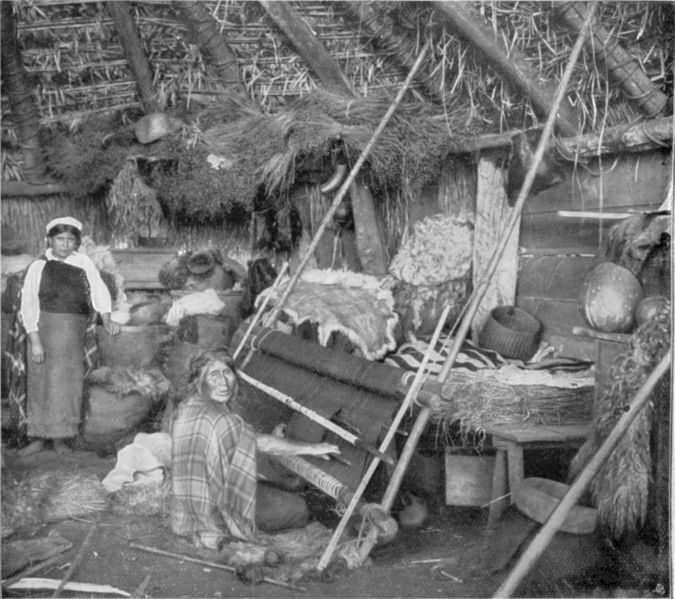
The weaving art proper was also almost exclusively in the hands of the women. In the east, aside from basket and ma/making. it was confined almost entirely to the twisting of ropes or bowstrings, and the making of belts, the skin fabric taking the place of the textile. In the South-West the Pueblo tribes wove native cotton upon looms of their own device, and, since the introduction of sheep by the Franciscan missionaries in the sixteenth century, the Navaho, enlarging upon their Pueblo teaching have developed a weaving art which has made the Navaho blanket famous throughout the country, the stripping, spinning, weaving, and dyeing of the wool all being their own. The Piute of Nevada and others of that region wore blankets woven from strips of rabbi/fur. Some early writers mention feather-woven cloaks among the gulf tribes, but it is possible that the feathers were simply overlaid upon the skin garment. It is notable that the Indian worker, man or woman, used no pattern, carrying the design in the head. Certain designs, however, were standardized and hereditary in particular tribes and societies.
Games and Amusements: The Indian gave himself up to pleasure when not under immediate necessity or danger, and his leisure time at home was filled with a constant round of feasting, dancing, story-telling, athletic contests and games. The principal athletic game everywhere east of the Missouri, as well as with some tribes of the Pacific coast, was the ball play adopted by the French Canadians under the name lacrosse and in Louisiana as racquette. In this game the ball was not caught with the hand, but with a netted ball-stick somewhat resembling a tennis racket. A special dance and secret ceremonial preceded the contest. Next in tribal favor in the eastern region was the game known to the early traders under the corrupted Creek name of chunkee, in which one player rolled a stone wheel along the ground, while his competitor slid after it a stick curved at one end like an umbrella handle with the design of having the spent wheel fall within the curve at the end of its course. This game, which necessitated much hard running, was sometimes kept up for hours. A somewhat similar game played with a netted wheel and a straight stick was found upon the plains, the object being to dart the stick through the certain netted holes in the wheel, known as the buffalo, bull, calf, etc. Foot races were very popular with certain tribes, as the Pueblo, Apache. Wichita and Crows, being frequently a part of great ceremonial functions. On the plains horse-racing furnished exciting amusement. There were numerous gambling games, somewhat of the dice order, played with marked sticks, plum stones, carved bones, etc., these being in special favor with the women. Target shooting with bow and arrows and various forms of dart shooting were also popular. Among distinctly women''s games were football and shinny, the former, however, being merely the bouncing of the ball from the toes with the purpose of keeping in the air as long as possible. Hand games, in which a number of players arranged themselves in two opposing lines and alternately endeavored to guess the whereabouts of a small object shifted rapidly from hand to hand, were a favorite tipi pastime with both sexes in the winter evenings, to the accompaniment of songs fitted to the rapid movement of the hands. Story-telling and songs, usually to the accompaniment of the rattle or small hand-drum, filled in the evening. Music was important, with the instruments being the drum, rattle, flute, or flageolet, eagle-bone whistle and other devices. Each had its special religious significance and ceremonial purposes, particularly the rattle, of which there were many varieties. Besides the athletic and gambling games, there were games of diversion played only on rare occasions of tribal necessity with sacred paraphernalia in keeping of sacred guardians. The Indian was fond also of singing and had songs for every occasion love, war, hunting, gaming, medicine, satire, childrens songs, and lullabies. The children played with tops, whips, dolls, and other toys, or imitated their elders in shooting, riding, and "playing house". War: Weapons were the knife, bow, club, lance and tomahawk, or stone axe, which was very soon superseded by the light steel hatchet supplied by the trader. To these, certain tribes added defensive armor, as the body-armor of rawhides or wooden rods in use along the northwest coast and some other sections, and the shield more particularly used by the equestrian tribes of the plains. As a rule, the lance and shield were more common in the open country, and the tomahawk in the woods. The bow was usually of some tough and flexible wood with twisted sinew cord, but was sometimes of bone or horn backed with sinew rapping. It is extremely doubtful if poisoned arrows were found north of Mexico, notwithstanding many assertions to the contrary. Where the clan system prevailed the general conduct of war matters was often in the keeping of special clans, and in some tribes, such as the Creeks, war and peace negotiations and ceremonials belonged to certain towns designated as "red" or "white". With the Iroquois and probably with other tribes, the final decision on war or peace rested with a council of the married women. On the plains the warriors of the tribes were organized into military societies of differing degrees of rank, from the boys in training to the old men who had passed their active period. Military service was entirely voluntary with the individual who, among the eastern tribes, signified his acceptance in some public manner, as by striking the red-painted war-post, or, on the plains, by smoking the pipe sent round by the organizers of the expeditions. Contrary to European practice, the command usually rested with several leaders of equal rank, who were not necessarily recognized as chiefs on other occasions. The departure and the return were made according to the fixed ceremonial forms, with solemn chants of defiance, victory, or grief at defeat. In some tribes there were small societies of chosen warriors pledged never to turn or flee from an enemy except by express permission of their fellows, but in general the Indian warrior chose not to take large risks, although brave enough in desperate circumstance. The custom of scalping the dead, so general in later Indian wars, has been shown to have been confined originally to a limited area east of the Mississippi. In many western tribes, the warrior''s prowess was measured by the number of his coups, or strokes upon the enemy. There was a regular scale according to kind, the highest honor being accorded not to one one who secured the scalp, but to the warrior who struck the first blow upon the enemy, even though with no more than a willow rod. There was no distinctive "war dance". Captives among the eastern tribes were either condemned to death or ceremonially adopted into the tribe, the decision usually resting with the women. If adopted, he at once became a member of a family, usually as representative of a deceased member, and at once acquired full tribal rights. In the Huron wars, whole towns of the defeated nation voluntarily submitted and were adopted into the Iroquois tribes. On the plains torture was not common. Adults were seldom spared, but children were frequently spared and either regularly adopted or brought up in a mild sort of slavery. Along the north-west coast, and as far south as California slavery prevailed and was the usual fate of the captive. Social Organization: Among most of the tribes east of the Mississippi, among the Pueblos, Navahos, and others of the South-West, and among the Tlingit and Haida of the north-west coast, society was based upon the clan system, under which the tribe was divided into a number of large family groups, the members of which were considered as closely related and prohibited from intermarrying. The children usually followed the clan of the mother. The clans themselves were sometimes grouped into larger bodies of related kindred. The clans were usually, but not always, named from animals, and each clan paid special reverence to its tutelary animal. Thus the Cherokee had seven clans; Wolf, Deer, Bird, Paint, Blue Holly, Long Hair and Wild Potato. A Wolf man could not marry a Wolf woman, but might marry a Deer woman, or one of any of the other clans, and his children were of the Deer clan or other clan accordingly. The clan system was limited to particular regions and seems to have been originally an artificial contrivance to protect land and other tribal descent. It was absent almost everywhere west of the Missouri, excepting in the South-West, and appears to have been unknown throughout the greater portion of British America, the interior of Alaska, and probably among the Eskimos. Among the plains tribes, the unit was the band, whose members camped together under their own chief, in an appointed place in the tribal camp circle, and were subject to no marriage prohibition, but usually married among themselves. With a few notable exceptions, there was very little idea of tribal solidarity or supreme authority, and where a chief appears in history as tribal dictator, as in the case of Powhatan in Virginia, it was usually due to his own strong personality. The real authority was with the council as interpreters of ancient tribal customs. Even such well-known tribes as the Creeks and Cherokee were really only aggregations of closely cognate villages, each acting independently or in cooperation with the others as suited its immediate convenience. Even in the smaller and more compact tribes there was seldom any provision for coercing the individual to secure common action, but those of the same clan or band usually acted together. In this lack of solidarity is the secret of Indian military weakness. In no Indian war in the history of the United States has a single large tribe ever united in solid resistance, while on the other hand other tribes have always been found to join against the hostiles. Among the Natchez, Tinucua, and some other southern tribes, there is more indication of a central authority, resting probably with a dominant clan. The Iroquois of New York had progressed beyond any other native people north of Mexico in the elaboration of a state and empire. Through a carefully planned system of confederations, originating about 1570, the five allied tribes had secured internal peace and unity, by which they had been able to acquire dominant control over most of the tribes from Hudson Bay to Carolina. If not prematurely checked by the advent of the whites, they might in time have founded a northern empire to rival that of the Aztec. Land was usually held in common, except among the Pueblos, where it was apportioned among the clans, and in some tribes in northern California, where individual right is said to have existed. Timber and other natural products were free, and hospitality was carried to such a degree that no man kept what his neighbor wanted. While this prevented extremes of poverty, on the other hand it paralyzed individual industry and economy, and was an effectual barrier to progress. The accumulation of property was further discouraged by the fact that in most tribes it was customary to destroy all the belongings of the owner at his death. The word for "brave" and "generous" was frequently the same, and along the north-west coast there existed the curious custom known as potlatch, in which a man saved for half a lifetime in order to acquire the rank of chief by finally giving away his entire hoard at a grand public feast. Enslavement of captives was more or less common throughout the country, especially in the southern states. In some tribes there was also a custom by which two young men became "brothers" through a public exchange of names. In all that chiefly concerned the home, the woman was the mistress, and in many tribes the women''s council gave the final decision upon important matters of public policy. Among the more agricultural tribes, as the Pueblos, men and women worked the fields together. Religion and Mythology: The Indian was an animist, to whom every animal, plant, and object in nature contained a spirit to be propitiated or feared. Some of these, such as the sun, the buffalo, and the peyote plant, the eagle and the rattlesnake, were more powerful or more frequently helpful than others, but there was no overruling "Great Spirit" as so frequently represented. Certain numbers, particularly four and seven, were held sacred. Colors were symbolic and had abiding place, and sometimes sex. Thus with the Cherokee the red spirits of power and victory live in the Sun Land, or the East, while the black spirits of death dwell in the Twilight Land of the West. Certain tribes had palladiums around which centered their most elaborate ritual. The priest was likewise the doctor, and medicine and religious ritual were closely interwoven. Secret societies were in every tribe, claiming powers of prophecy, hypnotism, and clairvoyance. Dreams were in great repute, and implicitly trusted and obeyed, while witches, fairies, and supernatural monsters were as common as in medieval Europe. From time to time, as among more civilized nations, prophets arose to purify the old religion or to preach a new ritual. Each tribe had its genesis, tradition, and mythical hero, with a whole body of mythological beliefs and folklore, and one or more great tribal ceremonials. Among the latter may be noted the Green-Corn Dance thanksgiving festival of the eastern and southern tribes, the Sun-Dance of the plains, the celebrated snake dance of the Hopi and the Salmon Dance of the Columbia tribes. Burial: The method of disposing of the dead varied according to the tribe and the environment, with burial being probably the most widespread. Tree, scaffold, and cave burial were common on the plains and in the mountains, while cremation was the rule in the arid regions father to the west and south-west. Northward from the Columbia the body was deposited in a canoe raised upon posts, while cave burial reappeared among the Aleut of Alaska, and earth burial among the Eskimo. The dread of mentioning the name of the dead was as universal as destroying the property of the deceased, even to the killing of his horse or dog, while the custom of placing food near the grave for the spirit during the journey to the other world was almost as common, Laceration of the body, cutting off of the hair, general neglect of the person, and ceremonial wailing, morning and evening, sometimes for weeks, were also parts of their funeral customs. Language: Nearly two hundred major languages, besides minor dialects, were spoken north of Mexico. Classified in fifty-one distinct linguistic stocks, given below, of which nearly one-half were represented in California. Those marked with an asterisk are extinct, while several others are now reduced to less than a dozen individuals keeping the language: Algonquian, Athapascan (Dn), Attacapan, *Beothukan, Caddoan, Chimakuan, *Chimarikan, Chimmesyan, Chinookan, Chitimachan, *Chumashan, *Coahuiltecan (Pakaw), Copehan (Wintun), Costanoan, Eskimauan, *Esselenian, Iroquoian, Kalapooian, *Karankawan, Keresan, Kiowan, Kitunahan, Kaluschan (Tlingit), Kulanapan (Pomo), *Kusan, Mariposan (Yokuts), Moquelumnan (Miwok), Muskogean, Pujunan (Maidu), Quoratean (Karok), *Salinan, Salishan, Shahaptian, Shoshonean, Siouan, Skittagetan (Haida), Takilman, *Timucuan, *Tonikan, Tonkawan, Uchean, *Waiilatpuan (Cayuse), Wakashan (Nootka), Washoan, Weitspekan (Yurok), Wishoskan, Yakonan, *Yanan (Nosi), Yukian, Yuman, Zuian.


 Gift Cards
Gift Cards